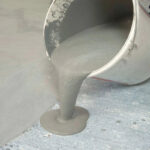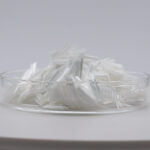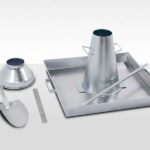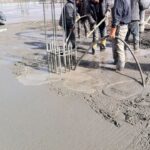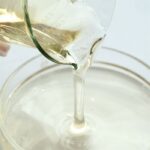In this article, we focus on the key factors affecting concrete slump and how to control them effectively in work and engineering projects.
Factors Affecting Concrete Slump
- Aggregate Gradation: Fine aggregate concrete has a much lower slump than coarse aggregate concrete under the same water content, due to the difference in coating rates between water, cement, and aggregates.
- Water Content: Variations in water content, especially from sand, directly affect slump. If you ignore these variations during mixing, the slump will be inconsistent.
- Cement Temperature: High cement temperature often gets overlooked. Hot cement raises concrete temperature, leading to reduced slump due to increased water absorption.
- Weighing Scale Errors: Inconsistent measurements from water and cement scales can cause significant changes in slump. If the scales are unstable, slump control becomes difficult.
- Admixture Dosage: The amount of admixture used has a direct impact on slump. Keep the dosage stable during production for better results.
- Gypsum Dehydration in Cement: During grinding, cement temperature rises, causing gypsum to dehydrate into hemihydrate gypsum. When water is added, it quickly reacts, reducing the flowability of concrete and affecting slump.
- Admixture-Cement Compatibility: If the concrete admixture is incompatible with the cement, the flowability will drop, leading to a significant slump loss.
- Cement Fineness: Finer cement increases water demand. Cement with pozzolanic materials often has a larger surface area, leading to a higher water demand and lower slump. If the fineness fluctuates, the slump will vary as well.
- Abnormal Cement Setting Time: Changes in fast-setting minerals during cement clinker calcination can lead to abnormal or inconsistent setting times, causing major slump fluctuations.
Controlling Concrete Materials
Test and compare parameters of all materials. Remove substandard materials or those with significant performance deviations. Adjust the mix design to compensate for problematic materials. For example, if the binder requires more water or the sand contains more fine mud, lower the theoretical water reduction value and increase the water dosage. Prioritize high-quality materials in the mix.
Preventing Free Water Loss
In hot and windy weather, take steps to cool and retain moisture at every stage. Cool aggregates with water, mark cement storage bins to use pre-cooled cement, and coordinate production, transport, and pumping to avoid delays. Implement cooling measures for the mixer trucks and pump pipes during transport.
Notes on Using Water-Reducing Agents
- Add the full amount of water-reducing agent to increase the water reduction rate and raise the initial slump of the fresh concrete.
- Increase air entrainment slightly to improve water retention. As air content drops over time, released water will replenish moisture loss. When controlling concrete workability, use spread value (≥500 mm) rather than slump for more reliable results.
- Extend concrete setting time slightly. Cement with large slump loss tends to have short setting times, so increase retarder dosage accordingly.
- Increase the use of slow-release water-reducing agents. These agents gradually release their water-reducing effects as cement hydrates and produces Ca(OH)₂, compensating for slump loss over time.
- High aggregate absorption during mixing intensifies admixture consumption. Pre-wet aggregates 3–5 hours before production, especially in hot weather, to reduce temperature and maintain water levels in the mix.
Concrete slump is an important indicator of the quality of ready-mixed concrete. Understanding the factors that affect slump helps produce high-quality concrete. Water, sand, stone, and cement all play a role in slump, with the coating thickness of aggregate having a critical impact. In future construction, pay close attention to slump conditions and make timely adjustments to ensure project quality.


